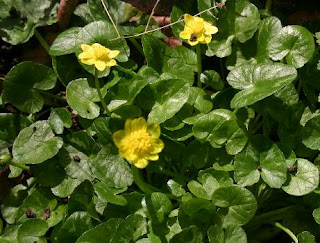
Isn't this just the most gorgeous flower? I picked up this Amaryllis hybrid when I was out at Glasshouse Works in Stewart OH last week. Ken has for years dabbled with hybridizing Amaryllis and this is just one of his creations. I doesn't have a name, as far as I know, but the color is just glowing, especially when the sun shines through it. And I love the bright, grass green throat.
I once tried to plant some Amaryllis seed that I had created by pollinating some of my many Amaryllis plants that live outside in the summer and in the greenhouse in the winter. I bring them into the house just as they are about to bloom so I can enjoy the flowers. It's a sure antidote to the winter blahs. Anyway, the seeds just sat there and did nothing, so I asked Ken how one starts Amaryllis seeds.
Anyway, after you dab the pollen and have gotten some seed, the trick, I am told, is that you need to take a pot or flat, depending on how much seed you have. By the way, these are large, flat seeds. Moisten the soil and then spread the seed on top. They need light to germinate, so you shouldn't cover them with soil. You can put a piece of plastic wrap over the pot so things don't dry out too fast. I'm going to try again next time I get some seeds, because I am truly in love with these big flowers that brighten my house and my life in the darkest days of winter.
Now, a little bit about how I grow my Amaryllis. Like I said, I keep them in the greenhouse in the winter and outside the rest of the year, as long as nighttime temperatures will be above 50 degrees. In the winter they get lots of sun (assuming it actually comes out - this past winter wasn't very good for sunny days). They spend their summers in the dappled shade of some old lilac bushes. I repot and fertilize them when I bring them out. They like to be somewhat potbound, so I don't size them up unless they have broken the pot, which they will do to plastic pots, especially when they create new offsets. They seem to like plenty of moisture, but I don't think they want to be soggy or sit in water. I don't mess so much with the stuff about giving them a rest at certain seasons. When they want a rest, they take one, dropping their leaves and just sitting there for awhile. During that time I water sparingly and only when they either send up a bloom scape or new leaves do I start with the regular watering again. There are some species ones with smaller flowers (mine have red ones) that don't go dormant at all and bloom occasionally throughout the year. Always in the winter, but sometimes again in summer and occasionally at other times too.
Amaryllis bloom scapes are pretty fragile things as they are hollow, quite tall and have up to 4 heavy blooms perched at the top. I set the smaller pot in which the plant is growing into a heavy ceramic pot to keep the whole thing from toppling over, and then I have a cup hook in the window frame to which I tie the scape. You don't really see the thin white string, but it keeps the whole thing safer. If the worst happens and the scape breaks off, I just put the stem in a tall vase (recut the bottom first) and the blooms will last almost as long that way.
So if you don't already have at least on Amaryllis (and why don't you???), you should certainly find one. They can be had for not too much money just after Christmas when they are considered 'left-overs'. As long as the bulbs are sound, they should do just fine. I would avoid the fancy catalog ones that come with a fancy pot. The same plant, without expensive pot can be had for much less and will be just as beautiful. Just think how many other plants you could buy with that extra money!
Four days in a row. Not a record, but good for me. See you tomorrow.
Jane
 I had good intentions of using this plant in my post yesterday, in honor or William and Kate's wedding, but I guess in my excitement of having my DSL back working I totally forgot.
I had good intentions of using this plant in my post yesterday, in honor or William and Kate's wedding, but I guess in my excitement of having my DSL back working I totally forgot.


















